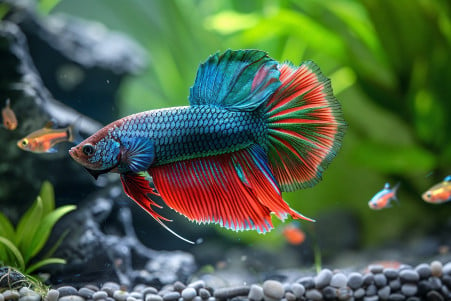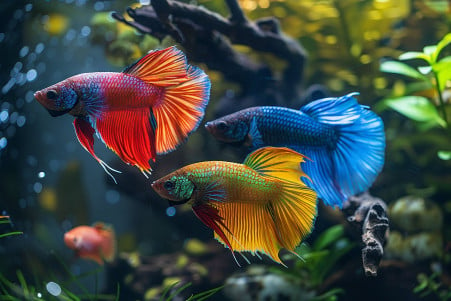Can Betta Fish Live With Other Fish? A Guide to Tank Mate Compatibility
4 February 2024 • Updated 4 February 2024

While betta fish are often associated with their solitary nature, there are ways to introduce other fish into their tank. With the right tank setup, including plenty of space and places to hide, betta fish can live with other fish such as cory catfish, harlequin rasboras, and snails.
However, you’ll want to make sure to avoid fish that are known to nip at fins and those that look like bettas. It’s also important to make sure that your betta isn’t showing signs of stress.
This article will cover a wide range of topics, including scientific research, animal behavior, and expert advice from the aquarium community. Together, these in-depth sources will help you understand the factors that contribute to a successful relationship between betta fish and other fish.
By combining information from the fields of ichthyology and aquarium keeping, you’ll be able to create a peaceful and aesthetically pleasing environment that meets the unique needs of betta fish and their tank mates.
Can betta fish live with other fish?
Why It’s Important to Understand Betta Fish Aggression
While betta fish are often sought after for their bright colors, they are equally well-known for their aggressive behavior, especially among males. In fact, the males are often referred to as Siamese Fighting Fish, and they are the most aggressive of the sexes, according to The Spruce Pets.
This aggression is most easily recognized by the fish’s flaring, which is when they puff out their gill covers to show other fish that they are a threat. This behavior is used to intimidate other fish, as well as to stake a claim on territory, food, and mates.
The history of the betta fish, which was selectively bred by Thai fisherman to be both beautiful and aggressive, is responsible for many of the triggers of this behavior. While the ornamental pet trade has expanded the roles of bettas, the genetic predisposition to aggression remains, according to a neurobiologist at Columbia.
In addition, environmental factors play a role in betta aggression. For example, bettas that are raised in groups are less aggressive, which means that their behavior can be largely shaped by their context and conditioning.
In contrast to males, female bettas are much less aggressive and can be kept in groups called “sororities.” However, this is only possible if you understand the nuances of betta fish behavior and know how to manage it.
As a result, it’s important to understand betta fish aggression when choosing tank mates. This will help you find a balance between the fish’s natural behavior and the conditions that can make their aggression worse or better.
Creating the Ideal Environment for Betta Fish
If you want to create a community tank, the environment that you create for your betta fish should mimic the peacefulness of the shallow waters in the wild.
While FishLab suggests that a 5-gallon tank is the minimum for a single betta, if you want to add other fish, a larger tank will help reduce the risk of territorial behavior.
Water quality is also important—BettaBoxx notes that while tap water is the most convenient and cost-effective option, it needs to be dechlorinated and tested to ensure that it has the right parameters for bettas, including a consistent pH level between 6.0 and 7.6 and a consistent temperature between 78 and 80 degrees Fahrenheit. The temperature is especially important because it regulates the metabolism of the betta fish.
Creating a complex environment isn’t just about making the tank look good—adding hiding spots with plants and decor can help reduce stress, which will help create a peaceful environment that will reduce the likelihood of aggression.
It’s also important to keep the water hardness at the right level and to make sure that there are no harmful toxins like ammonia, nitrite, and nitrate in the water, as these can all be harmful to bettas.
When you add a betta to this environment, it’s important to acclimate it to the tank, making sure that it gets used to the other fish in the tank. It’s also important to maintain consistent water quality, temperature, and pH levels. By doing this, you’ll be able to set up your tank for a successful community, which will allow you to move on to the next step: choosing your new tank mates.
Navigating the Seas: Finding the Right Tank Mates for Your Betta
If you decide to go on the adventure of finding the right tank mates for your betta fish, you’ll need to be discerning when it comes to compatibility. Size, temperament, and activity levels are all important when it comes to avoiding aggression.
Fishkeeping World suggests that if you want to add shoaling species like harlequin rasboras and neon tetras, you should add them in groups of five or more to help spread out aggression and keep the other fish from focusing on the bettas. Corydoras catfish are also great, peaceful bottom dwellers that won’t encroach on the betta’s space.
On the other hand, fish that look similar to bettas with long, flowing fins or that are brightly colored can lead to territorial issues. Avoid fish that are known fin nippers like some barbs and gouramis, as they can cause stress and harm to your betta.
Aqueon also notes that it’s important to make sure that each member of your community tank has enough space, with the general rule being one gallon of water per inch of adult fish, to make sure that the tank isn’t overstocked and that the fish aren’t stressed.
In the mosaic of community aquariums, every species has its niche, but it’s only when the requirements of all, including the betta, are thoughtfully addressed that genuine equilibrium is accomplished. By adeptly managing this underwater society, you can establish a flourishing habitat where the harmonious existence of diverse species will be impressive for observers.
How to Introduce Betta Fish to Other Fish
After you’ve added other fish to your betta’s tank, it’s important to watch them closely. According to PetMD, healthy bettas will be brightly colored, swim around a lot, and move their fins frequently.
If your betta is lethargic or pale in color, or if it’s not acting like it normally does, it may be stressed or aggressive. If the betta or the other fish are hiding, not eating, or have frayed fins, they may not be adjusting well to their new environment.
If you notice any of these signs, it’s important to act quickly to prevent injury. To give your fish a break from each other, you can put the aggressor or the victim in a separate quarantine tank, as suggested by a study in BMC Zoology, which notes that environmental factors can impact betta fish behavior.
To help ensure that your fish continue to get along, make sure you’re keeping up with regular tank maintenance, as recommended by PetMD. This includes changing the water regularly, cleaning the substrate, and making sure that the water quality is where it should be.
In addition, having a backup plan, like another tank, will help you be prepared to act quickly and make sure that all of your fish are safe. If you do these things, you’ll be more likely to have a happy, peaceful tank that’s good for both your betta fish and their tank mates.
Betta Fish Alone vs. With Other Fish: How to Tell If They’re Happy
The Siamese fighting fish, or betta, is known for being a loner, and many people believe that they are happiest when they are kept alone. However, the question of whether bettas are better off alone or with other fish is a bit more complicated.
PetHelpful explains that bettas are naturally solitary and do not need other fish to be happy. That said, some bettas are more aggressive and may not do well in a community tank, while others are more laid back and can be kept with other fish.
A study in Behavioral Ecology found that the social environment and internal states, including the motivation to reproduce, influence male betta aggression, which means that it is context-dependent. This shows that the way bettas react to living with other fish may depend on a number of factors.
In addition, wikiHow explains that a fish’s environment, including water quality and temperature, has a bigger impact on their health than whether or not they are kept alone or with other fish.
Because bettas have such a wide range of behaviors, it’s important for pet parents to consider the potential rewards of social interaction as well as the potential for stress and aggression.
If you’re thinking about keeping your betta in a community tank, make sure that you put your fish’s needs first by choosing tank mates carefully and keeping a close eye on their interactions. With the right care, betta fish can benefit from living with other fish without sacrificing their health or happiness.
Final Thoughts: Creating Peace in the Betta Aquarium
Throughout this discussion of betta fish tank mates, it has become evident that, with thoughtful planning, bettas can successfully coexist with other species in their watery world. This can only happen, however, if the betta’s natural tendencies toward aggression and solitude are taken into account and if tank mates are chosen that are not too similar to bettas and that don’t nip fins.
The right tank conditions, which include enough room, stable water quality, and environmental enrichment in the form of hiding spots, are also essential for the success of a betta community tank. These factors help ensure that the tank is a low-stress environment, which in turn reduces the likelihood of aggression and ensures the well-being of all the tank’s inhabitants.
A well-maintained community tank, with its constantly moving and changing array of colors, is not only beneficial for the fish that live in it but for the people who watch it as well.
By using the principles of informed and responsible fishkeeping, aquarists can create a beautiful and serene underwater world in which the betta fish, with its long, flowing fins, can live in peace with its tank mates. May we take the lessons of kindness and consideration for our aquatic friends to heart, as our care for them is reflected in the well-being of the world that surrounds them.


